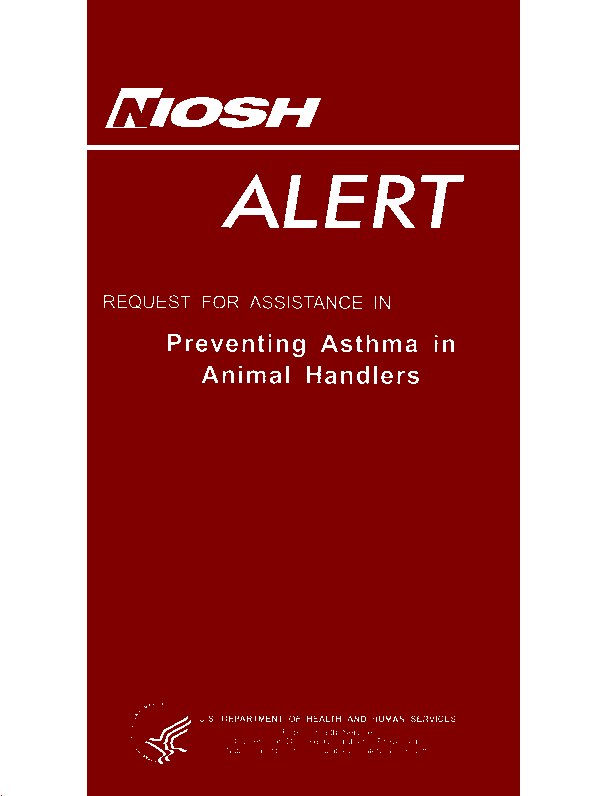Preventing Asthma in Animal Handlers
January 1998
DHHS (NIOSH) Publication Number 97-116

Types of Animal Handlers at Risk
All animal handlers appear to be at risk for developing work-related allergy symptoms. However, workers who had symptoms or signs of allergies before they were employed as animal handlers are more likely to develop animal-induced asthma [Beckett 1994; Chan-Yeung and Malo 1994]. Allergic workers, particularly those sensitized to domestic animals such as cats and dogs, are more likely to develop sensitivity to laboratory animals and asthma than nonallergic workers [Bryant et al. 1995].
Studies of workers exposed to animals associate many occupations with an increased risk of asthma and other respiratory symptoms [Lutsky et al. 1985; Zejda et al. 1993; Zuskin et al. 1992a,b; Bar-Sela et al. 1984]. These occupations include laboratory animal workers, veterinarians, livestock workers, garment workers, and horse handlers. Risks associated with some of these occupations are outlined here.
Laboratory Animal Workers
Workers are exposed to laboratory animals in the pharmaceutical industry, university laboratories, research units, and animal breeding facilities [Chan-Yeung and Malo 1994]. Most reactions to exposures in these facilities involve small animals such as rodents. Reactions associated with primates, cats, dogs, and domestic farm animals have also been reported [Lincoln et al. 1974].
Animal contact occurs during feeding, cleaning, dosing, sacrifice, surgery, and body fluid collection, measurement, and transport through the facilities [Harries and Cromwell 1982]. Workers are exposed to animal dander, hair, urine, saliva, tissues, and sera [Harries and Cromwell 1982].
Animal-related allergy is one of the most important health hazards encountered by laboratory animal workers [Newman-Taylor and Gordon 1993]. Health surveys of persons currently working with laboratory animals indicate that up to 56% are affected by animal-related allergies [Aoyama et al. 1992; Bardana 1992; Bryant et al. 1995; Hunskaar and Fosse 1993; Kibby et al. 1989; Lutsky et al. 1985; Newill et al. 1986; Zejda et al. 1993]. In a survey of 5,641 workers from 137 animal facilities, 23% had allergic symptoms related to laboratory animals. Of the workers with symptoms, 82% had nasal or eye symptoms, 46% had skin complaints, and 33% had asthma. These figures do not include former workers who became ill and could not continue to work.
Veterinarians and Veterinary Technicians
Increased prevalences of asthma, respiratory infections, and obstructive lung disease have been observed in veterinarians. Those who work with large animals seem to have fewer problems with asthma and allergies than those who work with small animals [Lutsky et al. 1985].
Livestock Workers
Rhinitis and occupational asthma are recognized effects of working with livestock such as cattle, hogs, sheep, and goats. Hog producers, particularly those who work in large confinement areas with inadequate ventilation, have been shown to develop wheezing and chronic coughing [Zejda et al. 1993; Zuskin et al. 1992b].
Garment Workers
Workers in the garment industry may have allergic reactions to pelts and fur as well as to textiles made from animal products such as wool, cashmere, alpaca, vicuna, and mohair [Bardana 1992].
Horse Handlers
Horse exposure poses a risk to agricultural workers, mounted law enforcement units, and race track and stable attendants.
Health Effects
Exposure to airborne animal allergens may at first result in nasal, eye, and throat irritation as well as skin hives [Ohman 1978; Lincoln et al. 1974]. As many as 50% of workers with these symptoms go on to develop asthma symptoms such as recurrent episodes of coughing, wheezing, chest tightness, and difficult breathing [Bardana 1992]. Nasal symptoms usually develop first; occupational asthma without nasal symptoms is uncommon. Once an individual has become sensitized to animals, allergy symptoms can occur after only a few minutes of exposure, or they may be delayed up to 8 hours or more. In severe cases, anaphylactic reactions (including shock) may develop, although rarely.
Symptoms of asthma may first appear long after beginning work with animals. Laboratory animal allergy usually develops within 36 months of starting exposure, and most cases develop after 6 to 36 months of exposure. Animal workers who do not become allergic within 3 years of exposure are less likely to develop the problem after longer exposures [Aoyama et al. 1992]. However, a study of 16 poultry workers with symptoms of asthma and rhinitis showed that the onset of symptoms can be delayed for up to 10 years [Bar-Sela et al. 1984].
After exposure is terminated, the nasal and eye symptoms often disappear shortly, but the lung symptoms tend to persist [Newman-Taylor and Gordon 1993]. In the poultry workers, nasal symptoms and asthma were persistent even after affected workers left the poultry house [Bar-Sela et al. 1984].
- Page last reviewed: June 6, 2014
- Page last updated: June 6, 2014
- Content source:


 ShareCompartir
ShareCompartir